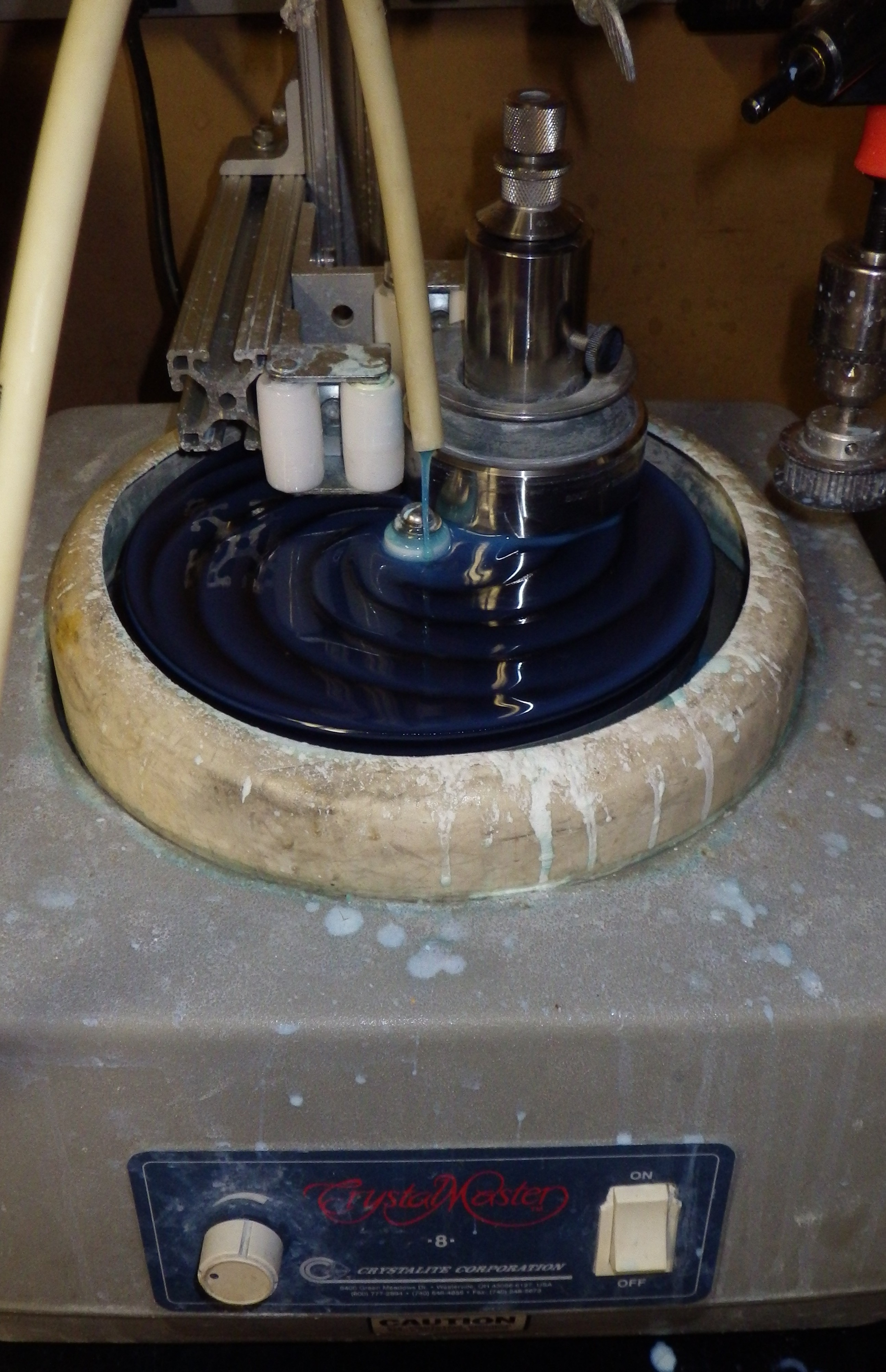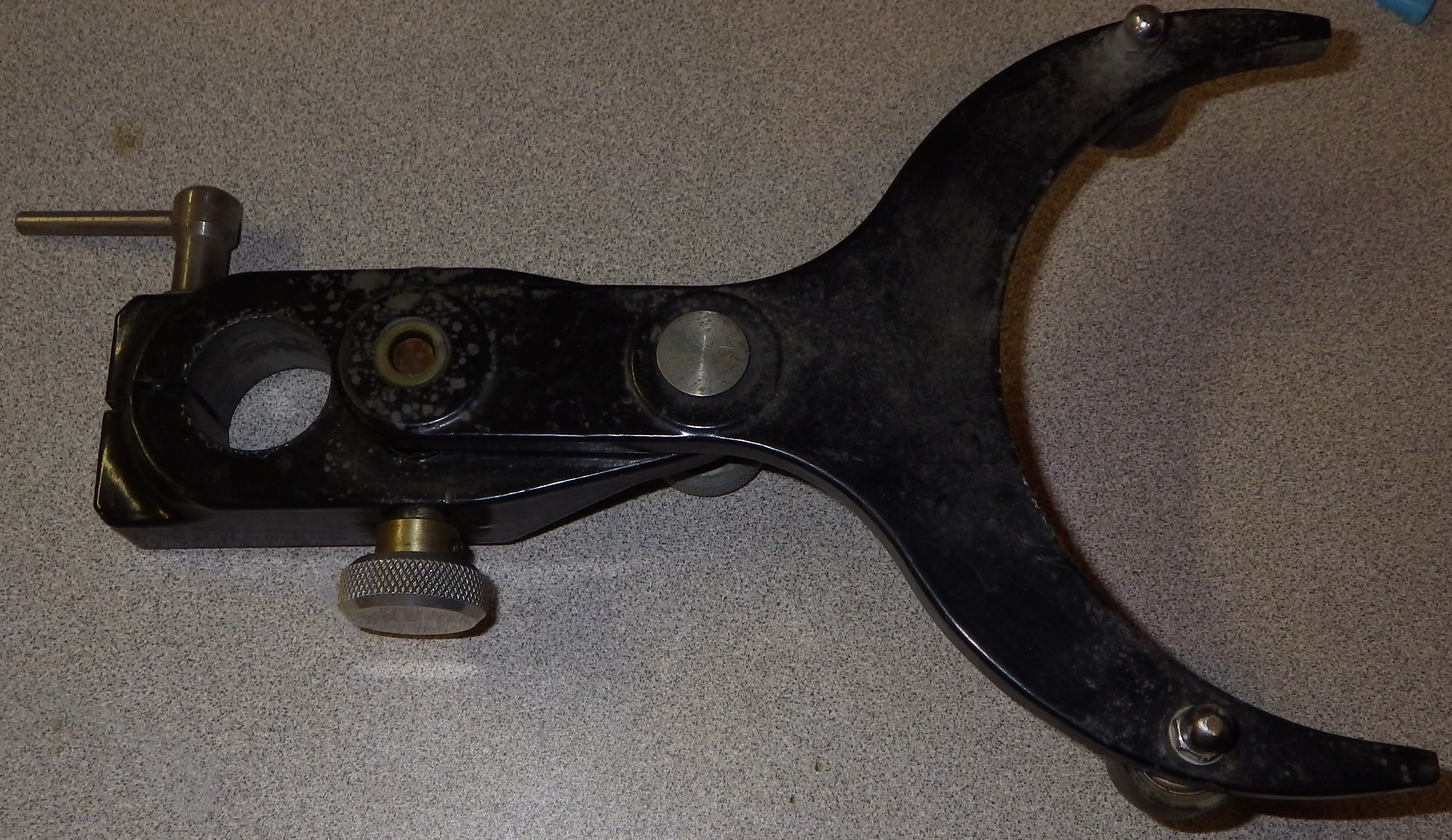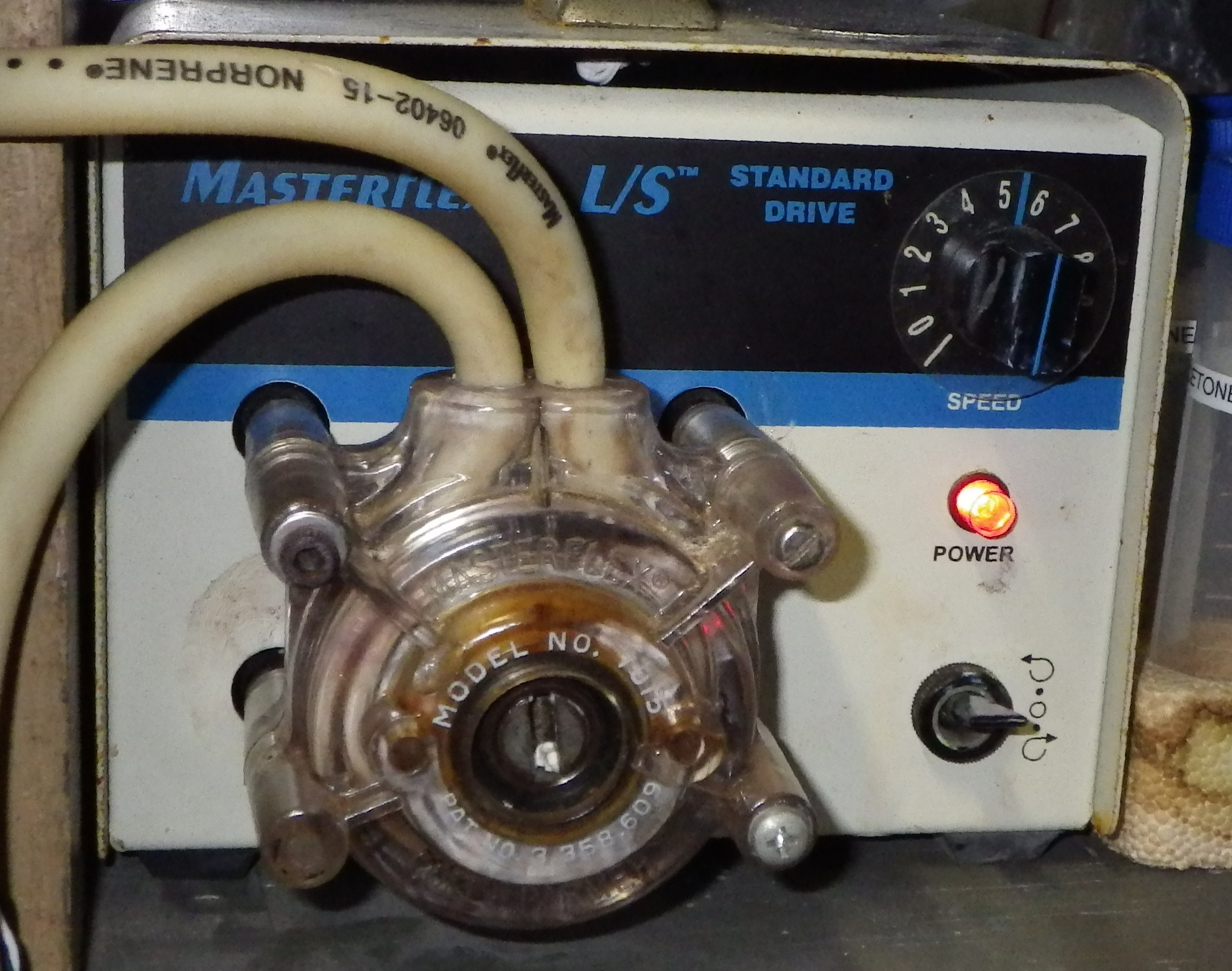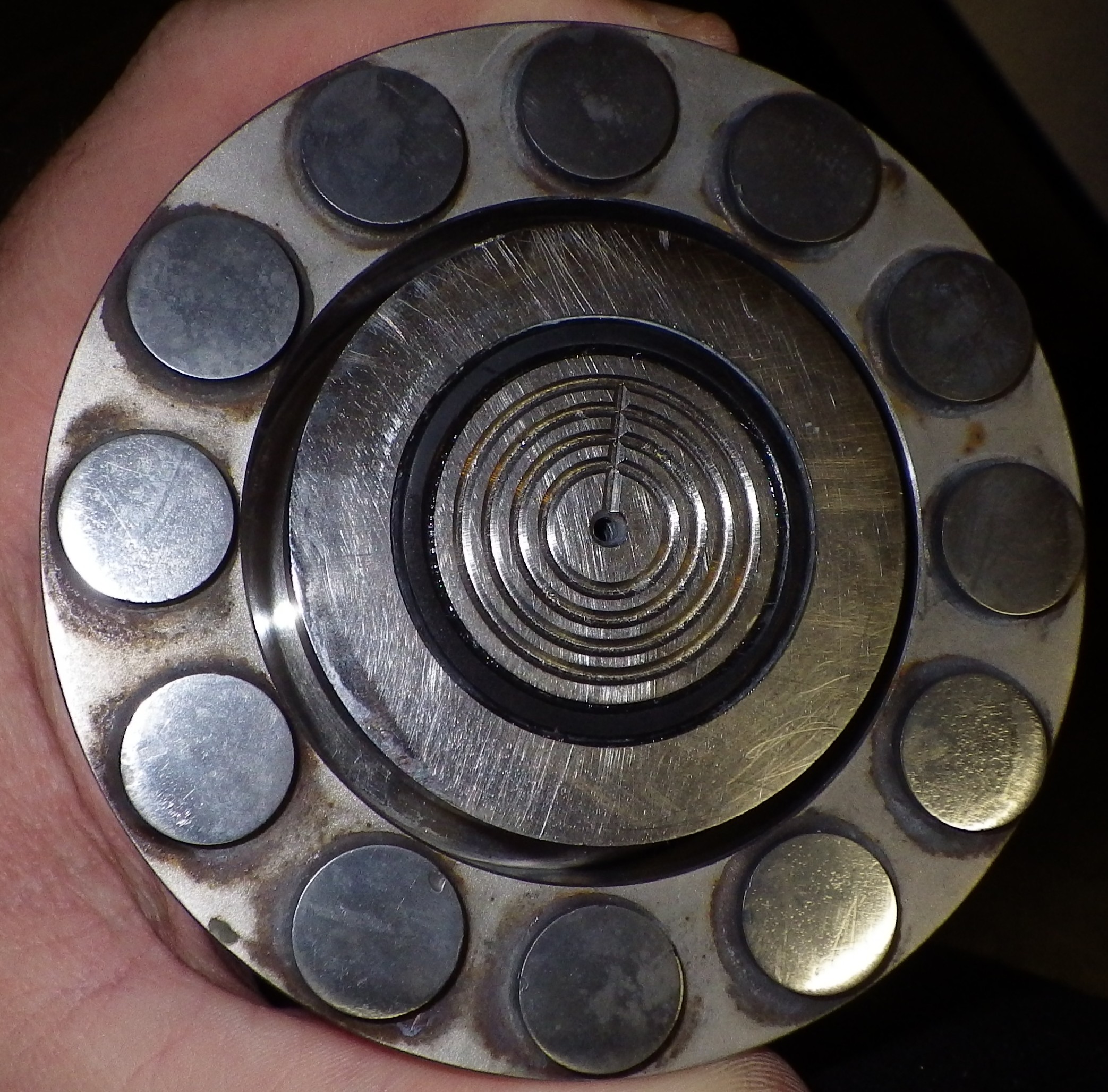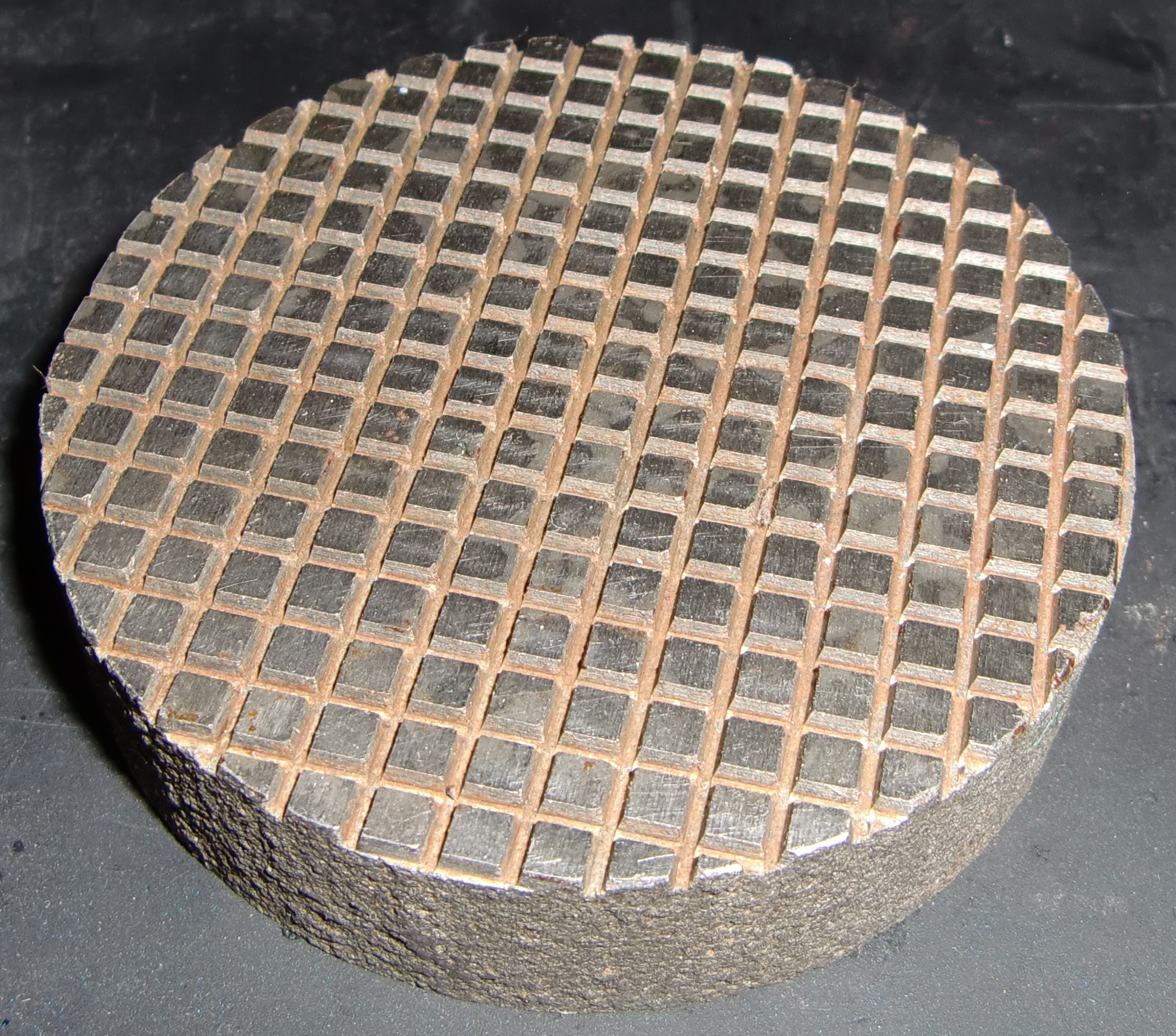This is an old revision of the document!
Table of Contents

See also: lapping
Machine types
Above: CrystalMaster 8 with South Bay Technology jig. Drive mechanism seen at right although belt is not attached
Samples can be polished manually by moving them in a figure 8 pattern for reasonably even polishing. However, this takes a while and can be tiring. Thus, most all IC work is done on a machine for so called “automatic lapping”.
The main components of a typical lapping machine:
- Lapping plate or “platen”: a ridged surface that spins against sample
- Platen drive motor: motor to spin lapping plate
- Speed controller: how fast the platen rotates
- Fixture drive motor: motor to put a controlled spin on lapping fixture
- Slurry pump: recirculates CMP solution after coming off of the platen
- York support: keeps fixture in place so it doesn't spin off
- Slurry reservoir: holds bulk of slurry solution
- Slurry filter: filters out contamination so it doesn't scratch the sample
- Splash guard: as disk spins silica spins out and would make a huge mess if not recaptured
Platen
Beyond IC RE, platen can be made of a variety of materials including:
- Cast iron
- Diamond
- Poromeric pad
However, cast iron and diamond are too abrasive for IC RE and so only polymeric pads are typically used.
Some machines can take magnetic apds such that one can switch, say, between a diamond and cast iron pad. As you should really only be using polymeric pads this feature will probably be less useful.
Above: typical stackup seen on JM machine consisting of (top to bottom):
- MTI 8“ Poromeric Polishing Pad (PSA) for final polishing - EQ-PP-8PSA-PC
- Two 8” Mater Plate ( Backing Plate ) for PSA Diamond plate, Sand Paper & Polishing Pad - EQ-MBP-8-2
- CrystalMaster 8 master lap
The first, the poromeric pad is the most important. It is essentially a soft pad to move abrasive around without actually scratching the die. The next forms a smooth surface on which the poromeric pad rests. Finally, the master lap is the interface to the machine itself and has ridges to keep backing plate in plate.
Originally the machine had a steel backed diamond pad directly on the master lap (attached with adhesive, removed with acetone + heatgun). In this setup the steel backing is much stiffer than the polishing pad and so serves as the backing plate.
York support
Above: york support from Logitech lapping machine. Note the screw on the side to make fine angle adjustments
Most machines have a stiff support arm with two rollers on it. This allows the fixture to rotate along with the machine to evenly lap the sample (planetary motion). They are usually attached to a sturdy post built into the machine
Alternatively, some machines (ex: Allied Tech's) attach the sample to a motor drive mechansim that directly supports the sample
Lost cost alternative: attach some rollers to a steady post and align to lapping machine
Some machines incorporate a fixture drive mechanism into the support arm
Nozzle
Typically uses ridged flexible nozzles like used on CNC machine coolant systems.
JM setup: open tube drips down. I originally used a nozzle but it was harder to clean (was drying out/clogging) and wasn't sure if it really helped since lapping jig conditions the pad
Slurry pump
Above: JM setup pump head
Because the abrasive is both corrosive and abrasive, it would be difficult to design a traditional mechanical pump to handle it. Fortunately, the flow rate is small which lends it well to peristaltic pumps.
JM setup:
- Cole Parmer Masterflex L/S
- Cole Parmer 7015 drive head (milled down to fit)
- Cole Parmer 06402-15 (MasterFlex Norprene (Neoprene))
Low cost alternative: put a reservoir above the machine and let it drip down (ex: sepreatory funnel w/ stopcock). You'll have to watch things more closely and the flow rate probably won't be as smooth as pressure will vary with fluid height. As proper flow rate is in fact pretty low should work well enough in practice. Even some higher end machines (ex: Allied Tech) ship with sepratory funnels instead of slurry pumps
Sample holding ("fixturing")
Above: bottom of South Bay Technology jig showing relieved sample holder and carbide pads. Note the center is hollow to allow air to escape for easy sliding
The device used to hold a sample to be lapped is called a lapping jig or lapping fixture. Typically made of stainless steel with carbide pads to resist the corrosive CMP solution. For example, the South Bay Technology 150 uses 303 SS with tungsten carbide pads [ instruction manual ].
Alternatively, the most basic method is to simply hold a die on a finger and press it into a spinning wheel. See tutorial. You won't get as uniform as a polishing but it should suffice if you just care about one particular section
Height control
Most fixtures have a fine pitch threaded on the ram going down the center bore. This allows it to be precision adjusted and locked to a nut to control precisely how much material to be taken off
Most fixtures also have one or two micrometers for monitoring sample height
Tripod
These are like above but include three precision setscrews for adjusting the angle of the center slide relative to the polishing plane. This helps to correct small mounting imperfections. These fixtures are much more expensive.
Example fixture: Logitech PP6
Pneumatic
Most fixtures rely on adding weights to vary the pressure. However, higher end fixtures instead accept air feeds that can be used to more accurately regulate the force applied.
Example fixture: MTI EQ-PF-4-1V
Conditioning ring
A ceramic ring around the sample holder evens out the slurry and filters out some impurities to the sample holder inside. The MTI low cost jig uses a stainless ring instead, I don't know if there is an advantage to one over the other.
The South Bay Technology jig above has a small rubber ring that might have been intended to be some sort of conditioner but unclear how. In any case the carbide pads seem to provide some conditioning
Facing off
Before a fixture is used it should be faced off to ensure that the surface is parallel
For tripod fixtures:
- Scribble on the fixture with a Sharpie
- Lap for a few minutes (or less if everything comes off quickly)
- Observe what area is removed
- Adjust tripod system to favor the areas that were not removed
- Repeat until desired parallelism is achieved
This procedure can also be used to verify that a sample is set reasonaby well by scribbling on it and doing a short polishing cycle
For other fixtures:
- Lap until surface is smooth
If the surface has damage you may consider using fine grit sandpaper first
Encased
TLDR: these fixtures are generally intended for sectioning and are not precise enough for parallel polishing
Some machines are designed for samples encased in blocks intended for metallurgy. These are also useful for irregularly shaped samples but these are rarely encountered in IC RE. There are two methods usually employed to encase specimins:
- Epoxy fill (most common)
- Compression mounted.
Example fixture: MTI EQ-PF-3H1W2
Epoxy mounting
TLDR: not suitable for parallel polishing
The epoxy mounting method is nice because is very safe to specimens. Epoxy isn't super cheap but is inexpensive compared to the net cost of doing this type of analysis. The sample is simply put into a well (typically made of silicone I think) that matches the machine size and epoxy is cast into a block. Different epoxies are used depending on requirements (ex: 1 hour cure for quicker processing vs 24 hour cure for higher quality cast).
I've had problems with samples floating up from epoxy getting under them. Most be a hard surface and its probably a good idea to press the die down during casting. A more viscous epoxy might work well at the cost of creating bubbles. Overall, the contamination and uncertainty this introduces doesn't seem to be the best approach.
Compression mounting
Compression mounting is quick and inexpenTLDR: not suitable for parallel polishing
sive per sample. It is intended for sectioning where the particular angle sectioned isn't important. Therefore, its not suitable for parallel polshing. Additionally, it uses high force and the the mix may need to be hot which can risk damaging specimens. See for example MTI's compression mounting powder (EQ-HM-Powder5L) + sample press EQ-MP-300.
Cast iron
Above: cast iron plate
Cast iron lapping plates are typically used with diamond paste to lap optics and metal surfaces smooth. They don't seem to be appropriate for use on ICs. I tried using CMP solution on a cast iron lapping plate and it noticeably corroded it within 10 minutes.
Professional (bench top)
In the professional category doesn't mean its a nice machine. More that it looks sturdy, has features, etc.
MTI
Looks like they sell some nice machines and jigs for reasonable prices
Machines:
- EQ-Unipol-800: 8“ basic / economy table top lapping machine, list $965
- EQ-Unipol-830: slightly nicer version of above, list $1395
- EQ-Unipol-810: much nicer version with York support and such, list $3395
- EQ-Unipol-820: dual 8”, list $2495
- EQ-Unipol-802: high end 8“, list $5996
- EQ-Unipol-1210: 12”, list $2096
- EQ-Unipol-1202: high end 12“, list $6950
- EQ-Unipol-160D: double sided 2”, list $8950. Notes that plates are made of stainless
Jigs:
- EQ-PF-3H1W2: economy 1“ sample jig, list $320
- EQ-PF-2-1: high precision, list $900
- EQ-PF-4-1V: fancy pneumatic version of above, list 1495
Logitech
Machines look to be top quality benchtop.
Machine:
- PM2: older benchtop
- PM2A: older benchtop
- CPM2: older benchtop
- BC 3000: 3 plate large “vacuum bonding system”
- A82471 1WBT2: 3 plate large “station wafer bonder”
- G69555 1WBS2: 3 plate large “wafer substrate bonder”
- A69510 1WBT2: 3 plate large “wafer substrate bonder”
Jig:
- PP 5: “precision lapping and polishing jig”, eBay BO 4200
Ultratec
These machines look nice.
Machine:
- Ultrapol 1200
PR Hoffman
- PR2: benchtop unit?
STRUERS
South Bay Technology
Make a bunch of small lapping fixture: http://www.southbaytech.com/shop/mlp1.shtml
Machines as well. Their 8” machine looks very similar to the Crystal Master 8: http://www.southbaytech.com/shop/900.shtml
Model 150 Hand Lapping Fixture instruction manual
KLA
Machine:
- TechPrep8
Professional (mixed size)
Allied High Tech Products Inc
Buehler
They seem to have a wide range of machines.
Minimet: small desktop polishers. Unlike traditional lapping machines that have a large spinning table I think these instead rotate the weight sitting on the sample in a small bowl.
Machine:
- Minimet 69-1000-160: small analog / knob with orange body
- Minimet 69-1000-160: small analog / knob with orange body
- Minimet 69-1000-160: larger analog / knob with white body
- PetroThin
- Varimet 60 1900: looks to be a nice benchtop unit
- Ecomet 2: benchtop unit
- Ecomet III: benchtop unit
- Automet 5: benchtop unit
- Metaserv 2000: dual 8“ benchtop
- “Buehler Metallurgical Apparatus Polisher”: heavy duty stand alone column type unit, quoted at 90 lbs
- Phoenix 4000
Jig:
- FibrPol: fiber jig
Leco
Machine:
- “AP-600 AUTO POLISHER”: floor model
- spectrum 2000: benchtop
Lapmaster
Machines:
- Speedfam: tends to be large but there are desktop models
- DFO-900: large
- Model 12: desktop
Jigs:
- Accupol: high precision small jig
Fiber
Domaille Engineering
Jigs: fiber polishers. not useful for IC work
Professional (large)
Peter Wolters
Machine:
- FL12P: large
Crane (packing company?)
Machine:
- Model 48: large
Engris
Machine:
- Hyprez cabinet large CNC lapping machine? Looks expensive
- Hypres 28SLM230VP-4: large floor unit
Accessories
AMAT MIRRA
Saw some parts labeled made by them, looked to be for a large machine
Transat
“Transat ALC-2120 Automatic Lap Controller”
Accretech
“PG300 Wafer Polisher Grinder Pads”
Praxair
“20” CMP Polishing Pads X20-80-80-53”
Rohm and Haas
“Polishing Pads Politex 30” 3010-01022“
CHESTERTON
Makes harsh environment seals, might be useful for DIY
Lapidary / basic / economy
Ameritool
Machine:
- 8” Ameritool universal grinder polisher lapidary
Covington
Machine:
- “8” Covington Super Diamond Flat Lap, Rock Grinder Polisher Lapidary model 5072ML“
Hi-tech Diamond
Machine:
- 8” All U Need: economy model found on eBay, list price $500-590
Crystalite Corporation
Machine:
- Crystal master 8: basic 8“ desktop unit. Expected to be used with water but could probably be used with CMP fluid as well. Looks like it collects in reservoir under disk and would need to be emptied out after use or modified with a feed for a slurry pump. List 600-900
Inland
Machine:
- Swap Top: economy lapping for jewelry. eBay list price 250-350
Related
Lapidary machine: more proper name referring to use on rocks. Tend to be less precise or more like faceting machines
Faceting machine; instead of York has a post with a precise angle adjustment and holder. This might make a good DIY conversion route
References
- eBay prism_electronics3 251218526825
- ebay csi.usa 190632451673
- ebay outback6 390927286035
- ebay theoldstereoguy 251663218367
- ebay surpluseq 310744003247
- eBay testeqe 130819201290
- eBay surpluseq 160956846235
- eBay auctionrus 320891999144

